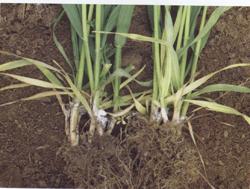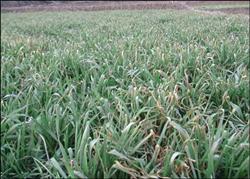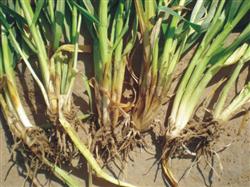Wheat catch four defenses in spring

In order to ensure high and stable yield of wheat, wheat management should grasp 4 prevention in time after spring. After spring, there is much rain. If the drainage is not smooth and the soil humidity is too large, it is easy to cause damage. Ditch drainage should be cleaned in time, plant ash scattered between rows, loose soil, increase soil permeability. Lodging prevention has great influence on wheat yield, so it should be done well as early as possible. For the plots with lodging tendency at wheat seedling stage, deep intertillage and suppression were carried out before wheat jointing, and chlormequat solution with concentration of 0.2%~0.4% was sprayed at the early stage of wheat jointing after dew drying in sunny days. After heading, roots, stems and leaves stop growing, the growth center turns to ear, and organic nutrients produced and stored by stems and leaves are continuously transported to grains. This period, often due to lack of fertilizer leaves premature aging, resulting in a decline in 1000-grain weight and yield, so should be timely fertilizer. Foliar fertilizer is usually applied. Nitrogen, phosphorus and potassium fertilizers are sprayed on the leaves from booting to early filling stage of wheat to supplement the deficiency of soil nutrients and prolong the functional period of leaves. The method is to add 1% urea to 0.2%~0.3% potassium dihydrogen phosphate solution and spray it once every 10 days for 2~3 times continuously. The effect is better when spraying once when the leaves are full. Spraying fertilizer time is best in the evening, should not be sprayed around noon under the scorching sun, if sprayed within 8 hours of rain, to make up spray. The middle and late stages of disease and pest control of wheat are the high incidence period of diseases and pests such as scab, rust, sharp eyespot and aphid, which have great influence on yield and quality, so it should be controlled as early as possible.
- Prev

Remedial measures for Spring Frost of Wheat
In February and March of every spring, cold air often breaks out to the south in the north, and the process of cooling is large, and the wheat jointing prematurely often suffers from freezing injury. At this time, for overgrown seedlings, repressive measures should be taken to restrain growth; the weak seedlings should be reasonably fertilized and turned strong to enhance their cold resistance, and at the same time, attention should be paid to listening to the sky.
- Next

Occurrence and control of wheat sheath blight in spring
Wheat sheath blight is a kind of fungal disease which is mainly transmitted by soil. With the improvement of the level of yield, the harm of the popularization of high-yield varieties and the management of wheat fields with heavy water and fertilizer is becoming more and more serious. Rhizoctonia solani can infect not only wheat, but also corn, rice, millet, sorghum and so on.
Related
- The first cup of black tea in spring, the flavor and history of tea gardens in Kenya, Africa
- The computer can not only choose potatoes, but also grow tea rice. AI will grow winter oolong tea champion.
- It is not only the inflated tea bitten by insects, but also engraved with the four seasons tea in Beipu.
- The Oriental Beauty Tea Festival in Zhuxian County takes the stage at the weekend to experience the plus-size feast of oil tea.
- & quot; Oriental Beauty Tea & Exploration of Emei in Hsinchu, the hometown of quot;
- The new variety of strawberry "Tainong 1" dessert is the first choice with mellow aroma. Crimson gorgeous
- History of Tea in Taiwan: from Wild Inner Mountain to Export Tea Garden
- Two types of Taiwan Oriental Beauty Black Tea won the British three-Star Award for Childhood Tea Xiang Zhang Jiaqi changed from pilot to champion tea maker.
- Banana species and varieties: the planting history of Taiwan Xianren banana and dwarf banana is long, is banana disease resistant?
- Coffee planting Technology: Qianjie Coffee from Seedling to harvesting

